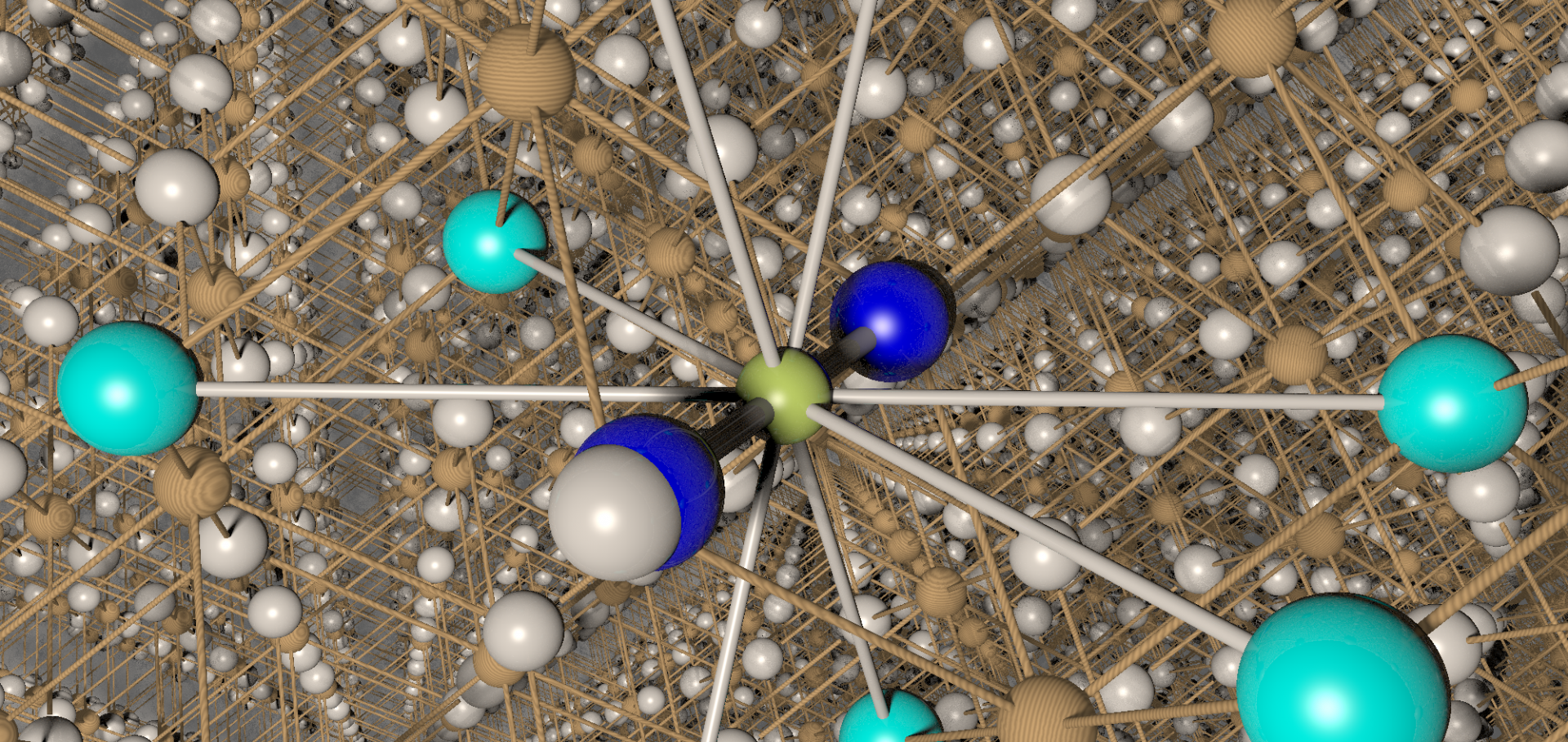Ca(2.5)Sr(0.5)GaMn2O8: diamagnetic Ga in control of the structural and electronic properties of a bilayered manganate.
J Am Chem Soc 126:39 (2004) 12517-12527
Abstract:
The temperature dependence of the crystal structure and electronic properties of brownmillerite-like Ca(2.5)Sr(0.5)GaMn(2)O(8) has been studied by neutron powder diffraction and muSR spectroscopy. The results show that short-range 2D magnetic order begins to develop within the perovskite-like bilayers of MnO(6) octahedra approximately 50 K above the 3D Néel temperature of approximately 150 K. The bilayers show a structural response to the onset of magnetism throughout this temperature range whereas the GaO(4) layers that separate the bilayers only respond below the 3D ordering temperature. XANES spectroscopy shows that the sample contains Mn(3+) and Mn(4+) cations in a 1:1 ratio, and the behavior in the region of the Néel transition is interpreted as a local charge ordering. Electron diffraction and high-resolution electron microscopy have been used to show that the local microstructure is more complex than the average structure revealed by neutron diffraction, and that microdomains exist in which the GaO(4) tetrahedra show different orientations. It is argued that the bonding requirements of diamagnetic gallium control the electronic behavior within the perovskite-like bilayers.Ca2.5 Sr0.5 GaMn2 O8 : Diamagnetic Ga in control of the structural and electronic properties of a bilayered manganate
Journal of the American Chemical Society 126:39 (2004) 12517-12527
Abstract:
The temperature dependence of the crystal structure and electronic properties of brownmillerite-like Ca2.5Sr0.5GaMn 2O8 has been studied by neutron powder diffraction and μSR spectroscopy. The results show that short-range 2D magnetic order begins to develop within the perovskite-like bilayers of MnO6 octahedra approximately 50 K above the 3D Néel temperature of ∼150 K. The bilayers show a structural response to the onset of magnetism throughout this temperature range whereas the GaO4 layers that separate the bilayers only respond below the 3D ordering temperature. XANES spectroscopy shows that the sample contains Mn3+ and Mn4+ cations in a 1:1 ratio, and the behavior in the region of the Néel transition is interpreted as a local charge ordering. Electron diffraction and high-resolution electron microscopy have been used to show that the local microstructure is more complex than the average structure revealed by neutron diffraction, and that microdomains exist in which the GaO4 tetrahedra show different orientations. It is argued that the bonding requirements of diamagnetic gallium control the electronic behavior within the perovskite-like bilayers.Magnetic phase separation in EuB6 detected by muon spin rotation
Physical Review B - Condensed Matter and Materials Physics 70:2 (2004)
Abstract:
We report results of the first muon-spin rotation measurements performed on the low carrier density ferromagnet EuB6. The ferromagnetic state is reached via two magnetic transitions at Tm=15.5 K and T c=12.6 K. Two distinct components are resolved in the muon data, one oscillatory and one non-oscillatory, which arise from different types of magnetic environment, and we have followed the temperature dependence of these components in detail. These results provide evidence for magnetic phase separation and can be interpreted in terms of the gradual coalescing of magnetic polarons.Organic and molecular magnets
Journal of Physics Condensed Matter 16:24 (2004)
Abstract:
Historically most materials in magnetic applications are based on inorganic materials. Recently, however, organic and molecular materials have begun to show increasing promise. Purely organic ferromagnets, based upon nitronyl nitroxide radicals, show long range magnetic order at very low temperatures in the region of 1 K, while sulfur based radicals show weak ferromagnetism at temperatures up to 36 K. It is also possible to prepare molecule based magnets in which transition metal ions are used to provide the magnetic moment, but organic groups mediate the interactions. This strategy has produced magnetic materials with a large variety of structures, including chains, layered systems and three-dimensional networks, some of which show ordering at room temperature and some of which have very high coercivity. Even if long range magnetic order is not achieved, the spin crossover effect may be observed, which has important applications. Further magnetic materials may be obtained by constructing charge transfer salts, which can produce metallic molecular magnets. Another development is single-molecule magnets, formed by preparing small magnetic clusters. These materials can show macroscopic quantum tunnelling of the magnetization and may have uses as memory devices or in quantum computation applications.Magnetic order and local field distribution in the hybrid magnets [FeCp*2 ][MnCr(ox)3 ] and [CoCp*2 ] [FeFe(ox)3 ]: A muon spin relaxation study
Journal of Materials Chemistry 14:10 (2004) 1518-1520


